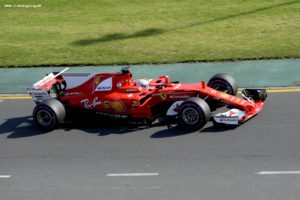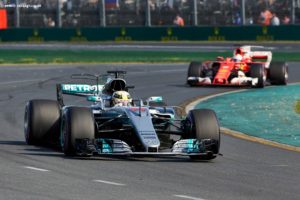The first Grand Prix to new regulations and with wider, more robust tyres brought about a complete change of approach in race strategy. With stronger tyres Melbourne is a one-stop race and that was the case for most runners this season.
 But strategy is still critical to race outcomes; at the front the race victory was decided by a strategy call from Mercedes driver Lewis Hamilton, who wanted to make an early stop and as he came out behind two cars and not into a gap, he lost the race win to Sebastian Vettel. Further back, track position proved to be the most valuable thing of all and overtaking proved hard, as Fernando Alonso managed to hold behind him the Force India of Esteban Ocon despite being 27km/h slower on the straights!
But strategy is still critical to race outcomes; at the front the race victory was decided by a strategy call from Mercedes driver Lewis Hamilton, who wanted to make an early stop and as he came out behind two cars and not into a gap, he lost the race win to Sebastian Vettel. Further back, track position proved to be the most valuable thing of all and overtaking proved hard, as Fernando Alonso managed to hold behind him the Force India of Esteban Ocon despite being 27km/h slower on the straights!
Pre-race expectations
It was clear from practice that the 2017 tyres have very low degradation, so much so that both the supersoft and soft tyres were capable of doing most of the race distance. There was little chance of building a tyre offset to another car, which defined the strategy and racing in recent times.
Whereas last year five or six laps fewer on a tyre would mean enough of a performance advantage to overtake, that was not the case this year and there was nothing teams could do to generate a sufficient offset in performance. To illustrate this, Daniil Kyvat managed to cover 34 laps in the opening stint on ultra soft tyres and was on a similar pace, before his stop, to Massa ahead who was on new supersofts! So most of the front-runners planned the same strategy, which was a first stint on Ultra softs and then a second stint on Supersoft.
Further back, we saw some teams split strategies; Magnussen and Palmer started on Soft tyres, Stroll on Supersofts. Sauber for example, started one car on soft and the other on supersoft, hoping to have a chance to use one car to hold the field behind it, to allow the sister car to gain positions as rivals pitted earlier than them. This is the kind of strategy one sees at Monaco and which can be very effective in putting two or three rivals behind your lead car. Another reason to employ an approach like this for teams at the rear of the field is that Melbourne usually has one of the highest attrition rates of the season. As the first race, many cars drop out with reliability issues and there are usually accidents and Safety Cars. So a smaller team can score points here, as we have seen many times in recent years.
This year just 13 cars saw the chequered flag, but five of the six front running cars finished, as did a Williams and both cars from Toro Rosso and Force India. So there were no points for cars at the back of the grid, like Sauber that tried the “Monaco approach”.
Ferrari vs. Mercedes – What were the differences between them and what turned the race?
 Last year Ferrari led 34 of the 57 laps of this race, but failed to win it due to poor choices. This year they started in second place, but picked up the lead after Mercedes stopped earlier than planned, losing the lead in the process. This was more a case of Mercedes yielding the win, rather than Ferrari taking it off them, as they could have done last year. But nevertheless they played their hand well and maximized the strengths of their new car, which works well on the new tyres. Unusually Mercedes ran into trouble on the tyres, while Ferrari had similar pace on Ultra Soft tyres and were also fast on the Softs.
Last year Ferrari led 34 of the 57 laps of this race, but failed to win it due to poor choices. This year they started in second place, but picked up the lead after Mercedes stopped earlier than planned, losing the lead in the process. This was more a case of Mercedes yielding the win, rather than Ferrari taking it off them, as they could have done last year. But nevertheless they played their hand well and maximized the strengths of their new car, which works well on the new tyres. Unusually Mercedes ran into trouble on the tyres, while Ferrari had similar pace on Ultra Soft tyres and were also fast on the Softs.
The Mercedes enjoyed its usual advantage on extreme engine modes in qualifying to get the pole. But there were also signs that the Mercedes operated better when there was cloud cover, while the Ferrari was stronger when the sun was out, raising the track temperature. It was only a small difference, but these factors all add up. Hamilton qualified ahead of Vettel and won the start; with Vettel following in second ahead of third place Bottas.
Hamilton tried to shake off Vettel, but the Ferrari persisted in its pursuit throughout the opening stint. The Mercedes was running with slightly less wing angle, so the straight-line speeds were among the fastest, while the Ferrari had slightly more downforce and top speeds were around the middle of the field. The Mercedes, in Hamilton’s hands, at least, was sliding more and this took the edge off the tyres. Hamilton radioed that they were overheating at one point and then on Lap 14 he had a small excursion, which cost a second.
His lap times returned to the mid 1m28s, but he was onto the team asking to be allowed to pit for new tyres. This is one of those situations where a team has to evaluate whether to heed its driver or just tell him to carry on. Teams further down the grid tend to overrule the driver, but a three times world champion needs to be listened to.
On this occasion it was the wrong thing to do.
 Mercedes was trying to build a 22 second gap to Raikkonen in fourth place, who was racing with Max Verstappen. The second Ferrari was not on the pace of the lead car, but neither was it dropping off at a sufficient rate to open a gap for Hamilton to drop into. By Lap 16, the lap before he stopped, it was just 16.2 seconds. Hamilton needed another six or seven laps to clear Raikkonen in a pit stop. But he came in at the end of Lap 17 and dropped back out behind both Raikkonen and Verstappen. He was put onto the soft, rather than the supersoft, because there were still 40 laps to go to the end.
Mercedes was trying to build a 22 second gap to Raikkonen in fourth place, who was racing with Max Verstappen. The second Ferrari was not on the pace of the lead car, but neither was it dropping off at a sufficient rate to open a gap for Hamilton to drop into. By Lap 16, the lap before he stopped, it was just 16.2 seconds. Hamilton needed another six or seven laps to clear Raikkonen in a pit stop. But he came in at the end of Lap 17 and dropped back out behind both Raikkonen and Verstappen. He was put onto the soft, rather than the supersoft, because there were still 40 laps to go to the end.
This was a gift to Ferrari, for whom Vettel now needed just to open the gap over Hamilton to 22 seconds to be able to pit and take the lead. Hamilton’s pace on the soft tyres was strong but he soon caught Verstappen and lost time behind him, handing the opening to Vettel to pit at the end of Lap 22. Ferrari covered Mercedes with the soft tyres, despite being only 35 laps from the flag.
The only risk there was that, if Hamilton were to do a Plan B strategy and switch onto supersoft or Ultrasoft tyres later on and then get lucky with a Safety Car deployed, this would leave Vettel vulnerable to attack in the closing stages. But Ferrari knew that Vettel’s pace on soft tyres was strong and that overtaking would be hard even with a tyre offset, so the risk was therefore manageable.
The only problem was that, despite having a safe gap to pit, Vettel had a slow in-lap, due to coming up behind Lance Stroll. He lost almost a second, so when he emerged from the pits he was only just ahead of the Verstappen and Hamilton battle. It took a few corners to warm up the tyres, but he managed to hold on. Mercedes toyed with the idea of the Plan B, but as the laps went by they didn’t see enough of a performance advantage in the other tyres to make the plan work.
Also it would have required Valtteri Bottas to move over and let Hamilton through, which would have been an unfortunate gesture to be asked to make on his Mercedes debut.
Alonso performs miracles ahead of Ocon, Hulkenberg
 Few commentators, or McLaren team members, would have given you odds on Fernando Alonso sitting in 10th place with ten laps to go of the Australian Grand Prix after the problems the team has had with Honda. Alonso’s car was 27km/h slower on the straights than the Force India of Esteban Ocon and yet he managed to keep it behind from the start to Lap 52. Nico Hulkenberg started ahead of both men, but fell behind them at the start and had a very frustrating afternoon.
Few commentators, or McLaren team members, would have given you odds on Fernando Alonso sitting in 10th place with ten laps to go of the Australian Grand Prix after the problems the team has had with Honda. Alonso’s car was 27km/h slower on the straights than the Force India of Esteban Ocon and yet he managed to keep it behind from the start to Lap 52. Nico Hulkenberg started ahead of both men, but fell behind them at the start and had a very frustrating afternoon.
Ocon tried the undercut on Lap 15, pitting for new soft tyres, but the slower warm-up of the softs meant that when McLaren reacted with Alonso and brought him in a lap later – putting him onto Supersofts for faster warm-up – the Spaniard was able to hold onto his position. Sadly he had to retire on lap 50. Sergio Perez tried an undercut on Carlos Sainz, albeit that he didn’t pick up the position in the pit stops, but passed him after Sainz came out of the pits and was struggling with the tyre warm up.



